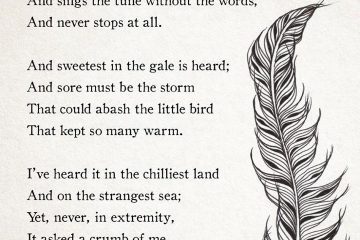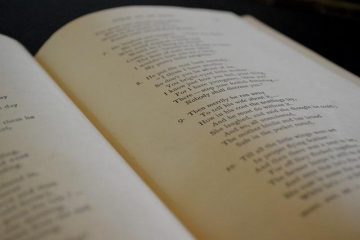Table of Contents
- Exploring Imagery: Crafting Vivid Pictures in Poetry
- The Power of Sound: Utilizing Rhyme and Rhythm Effectively
- Symbolism in Verse: Deepening Meaning Through Metaphors
- Line Breaks and Stanzas: Enhancing Flow and Impact
- Voice and Tone: Finding Your Unique Expression in Poetry
- Q&A
- Closing Remarks


Exploring Imagery: Crafting Vivid Pictures in Poetry
Imagery in poetry serves as a powerful tool that transports readers into the realm conjured by the poet’s words. By employing vivid descriptions and sensory details, poets can create mental pictures that resonate deeply with the audience. The use of similes and metaphors enhances this effect, painting vivid comparisons that evoke emotions and sensory experiences. A well-crafted line can make the reader taste, smell, hear, and feel the essence of a moment, transforming abstract feelings into concrete images that linger long after the poem is read.
When working with imagery, it is essential to tap into the five senses: sight, sound, smell, taste, and touch. This approach invites the reader to engage more fully and allows for a multi-dimensional experience of the poem. Poets often employ the following techniques to enhance imagery:
- Descriptive Language: Using adjectives and adverbs to create detailed descriptions.
- Personification: Giving human traits to inanimate objects, breathing life into the imagery.
- Symbolism: Utilizing symbols to represent larger concepts, making the imagery resonate beyond the literal meaning.
To illustrate the power of imagery in poetry, consider how poets create contrasting images that amplify their themes. Below is a table that showcases examples of imagery contrasts that can transform a poem’s emotional landscape:
| Imagery Type | Example | Emotional Impact |
|---|---|---|
| Bright Day vs. Dark Night | “The sun drips gold over the horizon” vs. “Shadows creep like whispers.” | Hope vs. Despair |
| Soft Textures vs. Harsh Surfaces | “The petals flutter like silk” vs. “The concrete cracks echo pain.” | Comfort vs. Suffering |
| Gentle Sounds vs. Thunderous Noise | “The breeze carries laughter” vs. “Sirens wail through the night.” | Peace vs. Chaos |


The Power of Sound: Utilizing Rhyme and Rhythm Effectively
Sound is an essential component of poetry, acting as an invisible thread that weaves through the fabric of words. By skillfully employing rhyme and rhythm, poets breathe life into their verses, creating a musical quality that can evoke emotions and enhance meaning. When rhyme is used effectively, it can create a sense of harmony and balance, allowing readers to be drawn into the poem’s cadence. Moreover, the strategic use of end rhymes or internal rhymes can leave a lingering impression that resonates long after reading.
On the other hand, rhythm serves as the heartbeat of poetry. It dictates the flow and pacing of the lines, influencing how the reader experiences the piece. Whether through iambic pentameter or free verse, rhythm can convey urgency, tranquility, or even tension. Poetry that utilizes meter provides a predictable beat that can lull the reader, while irregular rhythms can surprise and provoke thought. A carefully considered rhythm not only enhances the poem’s auditory experience but also reinforces its thematic elements.
To illustrate the impact of sound in poetry, poetical devices such as alliteration and assonance complement rhyme and rhythm by creating layered sonic textures. Incorporating a mix of these techniques can elevate the poem, making it richer and more engaging. Here’s a simple table showcasing these devices and their effects:
| Device | Description | Effect |
|---|---|---|
| Alliteration | Repetition of consonant sounds at the beginning of words. | Enhances musicality and memorability. |
| Assonance | Repetition of vowel sounds within words. | Creates internal rhythm and unity. |
| Consonance | Repetition of consonant sounds within or at the end of words. | Provides texture and emotional depth. |
Symbolism in Verse: Deepening Meaning Through Metaphors
Metaphors serve as the lifeblood of poetry, infusing verses with layers of meaning that go beyond the literal. By comparing seemingly unrelated concepts, poets invite readers to explore the emotional depths and complexities of their experiences. For example, when a poet describes a fleeting moment as a “whisper in the wind,” it evokes a sense of transience, enhancing the reader’s connection to the theme of impermanence. This transformative use of language not only paints vivid imagery but also creates a compelling emotional resonance, allowing readers to engage more deeply with the text.
The beauty of metaphors lies in their dual function: they can clarify and complicate. A straightforward metaphor can illuminate an abstract idea, making it more relatable. Consider the metaphor of “time as a thief,” which succinctly captures the feeling of lost moments and missed opportunities. Conversely, a more intricate metaphor can weave a narrative rich with ambiguity, encouraging varied interpretations. This duality adds to the depth and richness of poetry, challenging readers to unpack the layers of meaning embedded within the lines.
To illustrate how metaphors function within poetry, here’s a simple comparison of different types of metaphors:
| Type of Metaphor | Example | Effect |
|---|---|---|
| Simple Metaphor | “Life is a journey.” | Emphasizes progression and experiences over time. |
| Complex Metaphor | “The classroom was a battlefield.” | Conveys struggle and conflict in a learning environment. |
| Extended Metaphor | “Drowning in a sea of despair.” | Illustrates overwhelming feelings through a vivid, ongoing image. |
Ultimately, the skillful use of metaphor in poetry enriches the text, elevating it from mere words on a page to an engaging experience. By diving into the world of symbolism, poets can evoke emotions and invite reflection, creating a lasting impact that resonates with readers long after they’ve finished reading. The interplay of imagery and meaning fosters a deeper understanding and appreciation of the human condition, making metaphor an indispensable tool in the poet’s arsenal.


Line Breaks and Stanzas: Enhancing Flow and Impact
Line breaks and stanzas serve as the primary structure within a poem, guiding the reader through the emotional landscape of the text. By utilizing line breaks, poets have the freedom to control pacing and rhythm, creating a natural ebb and flow. Each break invites readers to pause and reflect, allowing emotions to simmer beneath the surface. For instance, a sudden line break can heighten tension, while a series of short lines may convey urgency or excitement.
Stanzas, on the other hand, function as thematic building blocks. They group related ideas, allowing poets to explore different facets of a single concept or emotion. By altering the length and shape of stanzas, poets can influence how their message is perceived. Consider the following styles that can be easily manipulated:
- Quatrains: Four-line stanzas, often with a specific rhyme scheme.
- Couplets: Two-line stanzas that usually rhyme, creating a concise thought.
- Sestets: Six-line stanzas that can provide a deeper dive into the subject matter.
When combined thoughtfully, line breaks and stanzas can amplify the emotional impact of poetry, transforming straightforward expressions of feeling into resonant, multifaceted experiences. Below is a simple table that illustrates how different stanza forms can affect meaning:
| Stanza Type | Effect on Emotion |
|---|---|
| Quatrain | Offers structure, stability, evokes contemplation |
| Couplet | Creates a sense of conclusion, sharpens focus |
| Sestet | Allows for narrative development, draws reader deeper |
By experimenting with these tools, poets can develop their unique voice and invite readers into an immersive world, where every line and stanza plays a crucial role in shaping the poetic experience.


Voice and Tone: Finding Your Unique Expression in Poetry
When crafting poetry, the essence of your voice and tone is paramount in conveying emotion and intention. Voice refers to your distinct personality as a poet, while tone reflects the emotional quality you imbue in your work. Together, they form the bridge between your thoughts and the reader’s experience. To explore your unique expression, consider the following approaches:
- Experiment with Perspective: Write from various viewpoints—be it first-person, second-person, or even as an inanimate object. This exercise can reveal surprising insights and deepen your poetic voice.
- Choose Your Words Wisely: The diction you select can influence tone dramatically. Opt for vibrant adjectives or stark, minimalist verbs based on the mood you wish to evoke.
- Mix Styles and Forms: Don’t confine yourself to a single style. Blend elements from contemporary and classical poetry to create a fresh, compelling voice.
Using imagery effectively can also enhance your tone, providing a backdrop that complements your voice. By creating vivid pictures crafted through descriptive language, you can draw your reader into a specific mood or emotion. A few effective techniques include:
- Metaphors and Similes: Comparing unlike things can create unexpected connections that resonate deeply.
- Symbolism: Use symbols to convey complex ideas, allowing readers to find personal meaning within your words.
- Alliteration and Assonance: The musical quality of your poems can be shaped through sound devices, enhancing the emotional impact of your tone.
To further explore the fusion of voice and tone, consider the following table that captures different poetical styles and their corresponding emotional implications:
| Style | Voice Characteristics | Tone Implications |
|---|---|---|
| Lyric | Intimate, personal | Reflective, emotional |
| Epic | Grand, heroic | Inspirational, noble |
| Haiku | Concise, observant | Calm, contemplative |
Q&A
Q&A: Unraveling Poetry Techniques
Q1: What are poetry techniques? A: Poetry techniques are various methods and tools that poets use to enhance their writing and evoke emotions. These techniques can include elements such as imagery, rhyme, meter, alliteration, metaphor, and symbolism, each contributing to the poem’s overall impact and meaning.Q2: Why is imagery important in poetry? A: Imagery plays a crucial role in poetry as it creates vivid mental pictures that allow readers to visualize the poet’s thoughts and feelings. By appealing to the senses, imagery establishes a deeper emotional connection, making the poem more impactful and relatable.
Q3: Can you explain what rhyme and meter are? A: Rhyme is the repetition of similar sounding words, often at the end of lines, which creates a musical quality. Meter, on the other hand, refers to the rhythmic structure of a poem, determined by the arrangement of stressed and unstressed syllables. Together, they enhance the lyrical flow and cohesiveness of a poem.
Q4: What is the role of metaphor in poetry? A: Metaphor is a powerful poetic device that allows poets to draw comparisons between unrelated things, providing new perspectives on familiar concepts. By saying one thing is another, metaphors enrich the text with layers of meaning, encouraging readers to explore deeper interpretations.
Q5: How does alliteration contribute to the sound of a poem? A: Alliteration, the repetition of consonant sounds at the beginning of words, adds a rhythmic and musical quality to poetry. This technique can create a pleasing sound pattern, enhance the mood of the poem, and emphasize particular phrases or ideas, making them more memorable.
Q6: What is symbolism, and how is it used in poetry? A: Symbolism involves using symbols—objects, characters, or colors—to represent broader themes or concepts. Poets use symbolism to convey complex ideas succinctly, allowing readers to derive deeper meanings and connect emotionally with the work, often beyond the literal interpretation.
Q7: Are there any contemporary techniques that writers are experimenting with? A: Yes! Contemporary poets often blend traditional techniques with modern elements, such as digital formats, visual presentation, and spoken word performance. Techniques like free verse and enjambment are also popular, allowing for a more fluid expression that breaks away from conventional structures.
Q8: How can I apply these techniques in my own poetry? A: Start by reading a wide range of poems to identify techniques that resonate with you. Experiment with incorporating different elements in your writing, such as playing with rhythm, trying out various imagery, or using metaphors. Practice is key—write regularly, revise, and engage with a community of poets for feedback and inspiration.
By understanding and utilizing these poetry techniques, both aspiring and seasoned poets can deepen their art and create more compelling, evocative works. Happy writing!




0 Comments